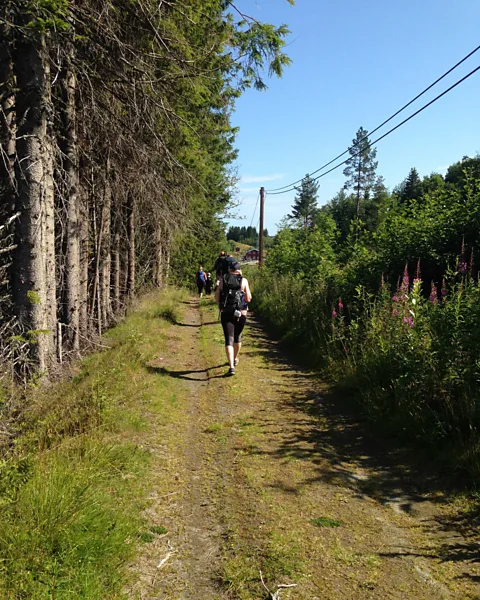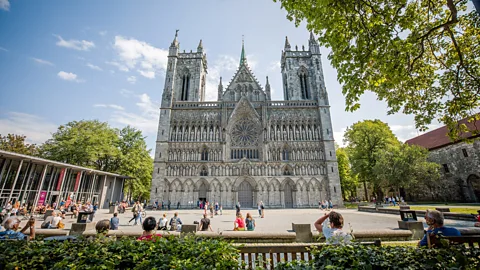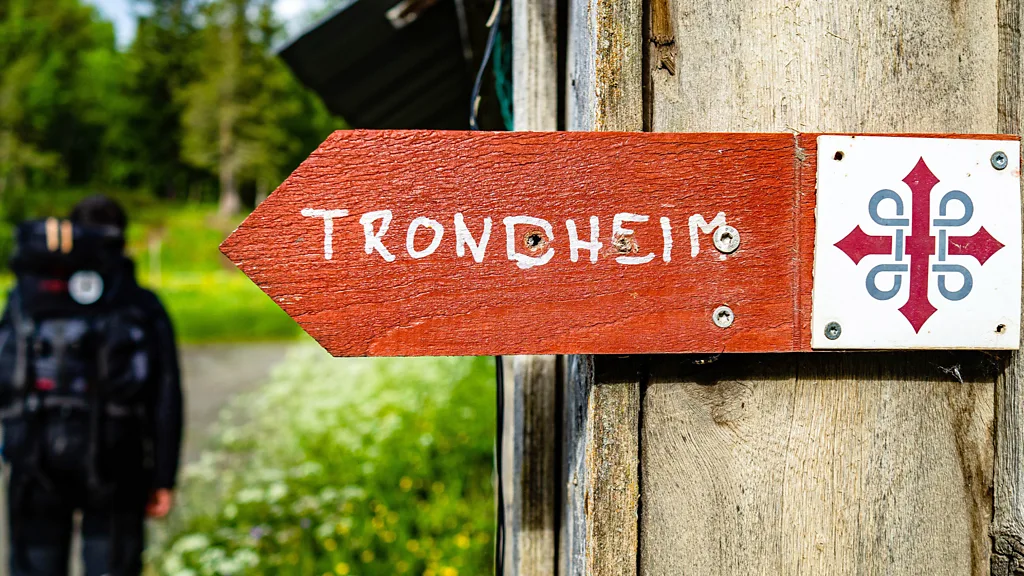Every summer, Spain’s iconic Camino bakes under extreme heat, but Norway’s St Olav Ways offer pilgrims a quieter, cooler path to redemption.
Picking my way across a hummocky field, I shiver as I reach the edge of one of Norway’s largest Viking-age graveyards. Vang, on the outskirts of Oppdal, is an undulating patchwork of nearly 900 turf-covered mounds, most dating from between 750 and 1050 CE. It’s not just the proximity to the deceased that gives me goosebumps but the temperature: a cool 13C in late August. Chilly for summer sightseeing, but perfect for hiking.
I am walking the Gudbrandsdalen path, one of nine St Olav Ways that thread in from Finland, Sweden and across Norway, all converging on Trondheim where Norway’s most famous medieval king, St Olav, is buried.
The path is quiet. Moss softens the stones along the route. Shafts of light pierce spruce forest; rivers run cold and clear enough to drink from them. This is pilgrimage, Nordic style. And in an era of climate extremes, it offers welcome respite from the heat of Europe’s iconic pilgrim trails.
In August this year, parts of Spain’s legendary Camino de Santiago sweltered at 45C. A 16-day heatwave fuelled wildfires, forcing authorities to close more than 50km of the route between Astorga and Ponferrada. Pilgrims were diverted or gave up; one walker died of heatstroke on a section of the Portuguese Coastal Way. Spanish media warned that the Camino was becoming not only overcrowded, but dangerous.
By contrast, the St Olav Ways promise what some now call a “coolcation”: milder air, long daylight, and space to walk without a throng of pilgrims.

“The paths combine countryside, culture, religion and encounters with locals. But what differs in Norway are the longer stretches of nature, mountains and pristine environment,” says Mattias Jansson of the National Pilgrim Centre in Trondheim. “Anecdotally we hear many pilgrims say that they visit Norway due to the cooler temperatures. This matters when you will hike for many hours a day.”
Back in the Middle Ages, the paths to Europe’s northernmost cathedral were among the four great pilgrim routes, along with Rome, Jerusalem and Santiago. After the Reformation, they fell into disuse. But in the late 1990s, the Norwegian government restored them to attract latter-day pilgrims.
Today the trails are well marked with the distinctive red cross of St Olav superimposed over Norway’s grey cultural heritage logo. These are painted on marker posts, rocks and wooden pendants hung from trees.
The Gudbrandsdalen path remains the most popular, running 643km from Oslo to Trondheim through farmland, forests, fjords and the open expanses of the Dovre mountains. The full route takes about a month, but shorter sections are easily walked. I opted for the final stretch between Oppdal and Trondheim, covering around 150km over a week. Heading north, the foothills of the Dovre rose to one side, fertile farmland where sheep and reindeer grazed stretched on the other. Tarred timber farm buildings, sun-darkened to a mottled sheen, lined the way.
The route is not only cooler than the Camino, but quieter. Last year almost half a million pilgrims received the Compostela certificate for walking 100km or more in Spain. In Norway the numbers are tiny by comparison, though growing. In 2015, around 700 hiked the last 100km to Trondheim; last year that figure rose to almost 1,000.
“Each summer we have more than 40 nationalities arriving on the pilgrim path to Nidaros Cathedral,” says Jansson. “The majority are from Germany, the Netherlands, UK and America.”
Many hikers are actively looking north.
“Of the people we talk to and meet, we hear that they are looking for alternatives to the Camino – both because of the amount of pilgrims in Spain, but also because of the extreme weather conditions,” says Sacha Kraan, co-owner of Nordic Pilgrim, a Dutch-based operator specialising in St Olav routes. “Often they hear about the Nordic trails when walking the Camino. They want to hike mostly alone through rugged landscapes with a rich history – and that is what you get along the Nordic trails.”
That history is visible in stave churches such as Ringebu, 180km north of Oslo. Once Norway had more than 1,000; now only 28 of these medieval wooden buildings survive. Elsewhere the path passes the ruined cathedral at Hamar, Bronze Age settlements, and rocks said to bear Olav’s horse’s hoofprint. Information boxes along the route open to reveal local stories: a clearing once used as a football pitch, another hacked out by a sorcerer.
Like the Camino, walkers here come for many reasons. In the mountains I met four Germans who had abandoned plans to hike in Romania after hearing of bears. Climbing up what locals wryly call “Norwegian flat”, I caught up with 73-year-old Synnøve Skåksrud, a retired psychiatrist who had already walked the Via Romea Germanica from northern Germany to Rome.
“Walking in Norway, where there are large variations in nature and weather, makes it more demanding than walking through [Southern] Europe,” she said. “The biggest challenge was rainy weather and slippery rocks, differences in altitude and rough terrain. [Elsewhere] in Europe, pilgrims meet in cafes and pubs; churches are open. In Norway, you must carry your food, and many churches are locked. Yet there are compensations: silence, birdsong, rain, fresh air and a sense of being part of the landscape rather than moving through it.”
Accommodation is as varied as the scenery. In Oppdal the Tourist Hotel provides a comfortable base with hearty breakfasts. A few days further on, the elegant Orkla Gjestebolig – once the guest house of a copper mine owner – offers art-filled rooms near the Orkla Industrial Museum. Mostly, though, pilgrim beds are humbler: converted barns with bunks where animals once slept and simple farmhouses with painted wooden furniture.
“The Nordic trails are not as developed as the Camino: there are fewer accommodations, and the infrastructure is still in its infancy,” Kraan admits. “There are no places to sleep every few kilometres and the standard varies – from hotel to B&B to a simple cabin in someone’s backyard. If you don’t pre-book in the main season, you might find yourself without a bed. But you can always set up your tent in the wild, thanks to allemannsretten, the Nordic ‘everyman’s right’.”
Three days in, I reached the Orkla, a crystal-clear river famed for salmon. Fish features heavily on menus: salmon, mussels and bakt klippfisk (baked salt cod), alongside pilgrim staples such as lamb stew. Most distinctive of all is rømmegrøt, a sour-cream porridge with butter, flour and salt — heavy but moreish, perfect fuel for long days. When the path dips into forest, the feast continues: blueberries and cranberries by the handful, or with luck, rare and aptly named cloudberries.

The final days bring the landscape down from high forest to fields of corn and barley. Joggers and roller skaters replace sheep and clapboard houses with fish-scale tiles signal that Trondheim is close. Then, suddenly, the spire of Nidaros Cathedral pierces the skyline – a brooding masterpiece of soapstone with intricate carvings and a great rose window glowing crimson in the late afternoon sun.
It is an arrival very different from Santiago. There are no queues in the beating sun, no saintly relics to see. Instead, a small, almost unnoticed altar near the wall marks Olav’s resting place, scattered with rose petals and pilgrim stones.
Spain’s Camino remains iconic, but the heat brought by climate change has made it increasingly challenging. In Norway, on paths once trodden by Vikings and saints, it is still possible to walk with climate, culture and conscience: across windswept landscapes, through traditional Nordic towns and beneath endless skies.
Sourse: BBC







































